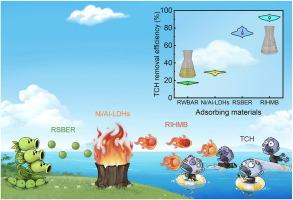Rose-inspired salt-responsive hierarchical microbead via in-situ growth of layered double hydroxide plates onto rosin-derived resin for efficient tetracycline removal: Ingenious design, advanced molecular simulations, and rethinking adsorption mass transfer
IF 8.1
1区 工程技术
Q1 ENGINEERING, CHEMICAL
引用次数: 0
Abstract
Flower-like Ni/Al layered double hydroxides (Ni/Al-LDHs) were in-situ grown on rosin-derived resin to design a rose-inspired hierarchical microbead (RIHMB), which is efficient in removing tetracycline hydrochloride (TCH) from water system. The ingeniously designed dual-layer structure of RIHMB features an inner layer rich in quaternary ammonium (–R4N+) that strongly attracts negatively charged TCH, and a rose-like outer layer with numerous pores to accommodate the adsorbates. RIHMB exhibits exceptional reusability, achieving over 92 % TCH removal efficiency after five cycles. Molecular dynamics simulations demonstrate that RIHMB not only adsorbs TCH with high efficiency but also facilitates its remarkably rapid release (NaCl as desorbent). This outcome is attributed to the porous structure of Ni/Al-LDHs, which traps TCH and acts as a physical barrier, preventing direct interaction with –R4N+. Then, chloride ions in the desorbent neutralize the positive charge of RIHMB, reduces its adsorption affinity for TCH, and promotes rapid desorption. A novel Wen Li-Wei Wei adsorption mass transfer model is presented, which reveals the collective influence of liquid-film diffusion, pore mass transfer, and sorption onto active sites on adsorption mass transfer, providing valuable insights into the underlying mechanisms. Multiple quantum chemical theoretical calculations were integrated to quantify the contributions of charge interaction, hydrogen bonding, π-π interaction, and van der Waals force to adsorption. A scale-up experiment conducted on a real water system offers a promising strategy for the remediation of environments contaminated with antibiotics.

通过在松香衍生树脂上原位生长层状双氢氧化物板而获得的玫瑰启发盐响应分层微珠,用于高效去除四环素:巧妙的设计、先进的分子模拟以及对吸附传质的重新思考
本文章由计算机程序翻译,如有差异,请以英文原文为准。
求助全文
约1分钟内获得全文
求助全文
来源期刊

Separation and Purification Technology
工程技术-工程:化工
CiteScore
14.00
自引率
12.80%
发文量
2347
审稿时长
43 days
期刊介绍:
Separation and Purification Technology is a premier journal committed to sharing innovative methods for separation and purification in chemical and environmental engineering, encompassing both homogeneous solutions and heterogeneous mixtures. Our scope includes the separation and/or purification of liquids, vapors, and gases, as well as carbon capture and separation techniques. However, it's important to note that methods solely intended for analytical purposes are not within the scope of the journal. Additionally, disciplines such as soil science, polymer science, and metallurgy fall outside the purview of Separation and Purification Technology. Join us in advancing the field of separation and purification methods for sustainable solutions in chemical and environmental engineering.
 求助内容:
求助内容: 应助结果提醒方式:
应助结果提醒方式:


